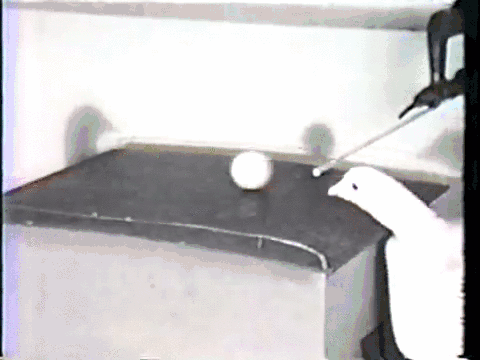B.F. Skinner, who felt we could use some training, created a Teaching Machine in the 1950s to help improve our behavior. Thanks to the wonderful 3 Quarks Daily, I read Sophia Nguyen’s Harvard Magazine article about the reconsideration of Skinner’s contraption in the computer age, as classrooms become increasingly plugged in. The goal for such machines should, of course, be something other than teaching us chickens how to play tic-tac-toe. In investigating gaming as learning, Nguyen writes of the vision of designer Eric Zimmerman:
Future generations will understand their world in terms of games and systems, and will respond to it as players and designers—navigating, manipulating, and improving upon them.
The opening:
ON NOVEMBER 11, 1953, psychology professor B.F. Skinner sat in a fourth-grade math class, perturbed. It was Parents Day at his daughter Deborah’s school. The lesson seemed grossly inefficient: students proceeded through the material in lock-step, at the same pace; their graded assignments were returned to them sluggishly.
A leading proponent of what he called “radical behaviorism,” Skinner had devoted his career to studying feedback. He denied the existence of free will and dismissed inner mental states as explanations for outward action. Instead, he focused on the environment and the organism’s response. He had trained rats to push levers and pigeons to play Ping-Pong. A signed photo of Ivan Pavlov presided over his study in Cambridge. Turning his attention to a particular subset of the human animal—the schoolchild—Skinner invented his Teaching Machine.
Roughly the size and shape of a typewriter, the machine allowed a student to progress independently through a curriculum, answering test items and getting instant feedback with a few pulls of a lever. “The student quickly learns to be right. His work is pleasurable. He does not have to force himself to study,” Skinner claimed. “A classroom in which machines are being used is usually the scene of intense concentration.” With hardly any hindrance from peers or teachers, thousands of students could receive knowledge directly from a single textbook writer. He told The Harvard Crimson, “There is no reason why the school room should be any less mechanized than the kitchen.”
Sixty years later, Skinner’s reductionist ideas about teaching and learning continue to haunt public education—especially as it’s once again being called upon to embrace technology.•
_______________________________
Teaching machine and programmed learning, from 1954:
Tags: B.F. Skinner, Eric Zimmerman, Sophia Nguyen

